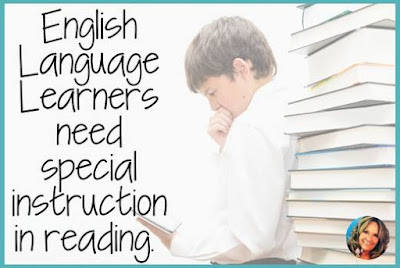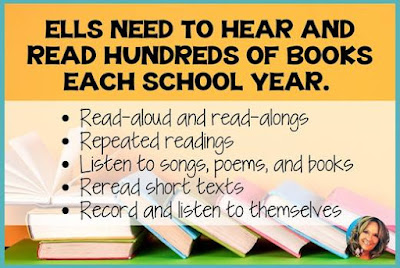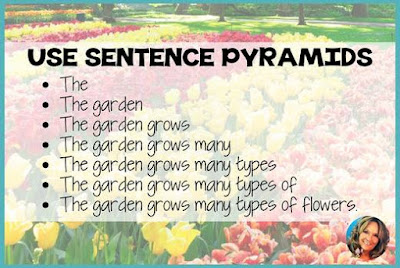Are you ready to be an amazing ESL teacher this year for the English Language Learners in your classroom?
This is the second in a three-part series focusing on teaching English Language Learners. This post is filled with ESL teacher tips to help your ELLs with reading skills.
Check out part 1 focusing on listening and speaking skills and part 3 is upcoming and it's all about writing and grammar.
Keep reading for activities and games for the English Language Learners in your classroom.
A quick review of language skills for teaching ELLs
The four basic language skills are listening, speaking, reading, and writing, with many teachers also including grammar as a fifth. I agree!
Educational achievement for ELLs requires proficiency in all five skills so these basic language skills are must-haves! But often must-haves aren’t the most fun but you’re in luck because this post suggests activities and games for your daily lessons to incorporate some or all of the skills to build fluency and language competency. This combination is the key to academic success for the English Language Learners in your classroom.
So let’s dive into how to teach reading skills.
Teaching English Language Learners: Reading skills
Building reading skills requires amazing ESL teachers to teach and practice this skill with their students. So it’s important to find ways to incorporate this into a variety of activities for the English Language Learners in your classroom.
Reading skills are the phonetic aspect of a language. We know there are five aspects of reading:
1. Phonemic awareness
2. Phonics
3. Vocabulary
4. Reading comprehension
5. Fluency
These aspects of reading are interconnected and must be developed in full to create success in reading for ELLs.
ELLs need special instruction in reading.
Start with Phonemic awareness
Make sure your ELLs can identify and manipulate the 41 phonemes in English. I use songs, tongue twisters, chants, poems and rhymes. Practice and repetition is the name of the game here!
Phonics, phonics, phonics!
Teach your students how to produce the sounds of the alphabet, create the sounds of the blends and understand the intricacies of those sounds that a native speaker produces without thought. Think of the 3 different sounds of ed. Native speakers can produce them easily, while these sounds need to be specifically taught to ELLs.
Be aware of which English sounds are in the native language of your students and which sounds are not. Special instruction and practice is necessary for all the new sounds your ELLs will need to learn.
Vocabulary is a must
Many ELLs do not have a high level of English in the home. Vocabulary, especially academic vocabulary is a must to teach.
Focus on word clusters and related words. I love vocabulary expansion because students can see how a word changes from verb to noun to adjective and many times to adverb.
Use pictures and visuals when introducing new words.
Practice, practice, practice.
Offer kid friendly definitions.
Make learning vocabulary fun with games and activities. One of my favorite ways to teach math vocabulary is to tape a picture with the word and meaning to the back of each of my chairs. After students sit down they have to read the word and the meaning to the class.
Looking to expand your math resources for the English Language Learners in your classroom? Check out these multiplication timed tests to help with math fluency.
Reading fluency
Fluency is best achieved with lots of reading and hearing and seeing books and more books! Listening to fluent readers is a great model for ELLs. Audio books and reading with older students engage young students.
Read-aloud, read along, repeated readings and listening to songs, poems, and books should be included every day with every ELL. Rereading short texts and then recording and listening to themselves help ELLs read more fluently. Songs help students’ fluency by re-reading the song and singing the lyrics while reading them. ELLs need to hear and read hundreds of books each school year.
Teaching reading skills can be FUN! Here are a few of my ideas:
Reading Fluency Stations: Students rotate through each station to record their reading.
Read it like a mouse
Read it like a monster
Read it like a robot
Read to a stuffed bear
Read with funny glasses
Read into a phonics phone
Read with a flashlight
Read with a stopwatch
Read to a buddy
Sentence Punctuation: Students read sentences while changing the ending punctuation. I write these on sentence strips and hang them on the wall for students to read…
My dog likes to bark.
My dog likes to bark?
My dog likes to bark!
Sentence Pyramids: Students start at the top and repeat down the list. The repetition helps with their memory and the practice helps with their fluency and comfort.
The
The garden
The garden grows
The garden grows many
The garden grows many types
The garden grows many types of
The garden grows many types of flowers.
Using these ideas with the English Language Learners in your classroom will mean you are well on your way to becoming an amazing ESL teacher this year. And you can be amazing without worrying about planning all of the lessons all of the time! Check out these bundles whether you have newcomers, intermediate, or advanced ELLs!
I hope you found an educational nugget or two that you can use this year with your ELLs! And don’t forget to check out part 1 in this series all about listening and speaking skills.
Be Bold!
Be Great!
Be Amazing!
Your partner in ESL!
Lori





No comments:
Post a Comment